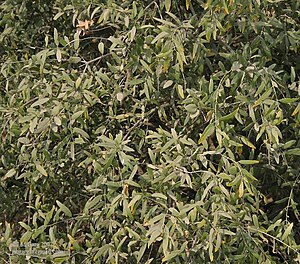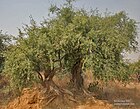Note: This is a project under development. The articles on this wiki are just being initiated and broadly incomplete. You can Help creating new pages.
Difference between revisions of "Salvadora oleoides"
| Line 8: | Line 8: | ||
==Chemical Composition== | ==Chemical Composition== | ||
| − | <ref name="chemical composition"/> | + | The main chemical constituents in the extracts were: N-benzylbenzamide (71.08%), decane (3.17%), stigmasterol (3.17%), 9-desoxo-9-x-acetoxy-3,8,12-tri-O-acetylingol (2.33%), and β-sitosterol (2.15%).<ref name="chemical composition"/> |
==Common names== | ==Common names== | ||
| − | {{Common names|sa=Pilu|en=Bada Peelu|gu=Mithijar|hi=Bada pilu|kn=|ks=|ml=|mr=God-pilu|pa=Jaal|ta=Peru-kalarva|te=}}<ref name="Common names"/> | + | {{Common names|sa=Pilu|en=Bada Peelu|gu=Mithijar|hi=Bada pilu|kn=|ks=|ml=|mr=God-pilu|pa=Jaal|ta=Peru-kalarva|te=|en=Bada Peelu, Large toothbrush tree}}<ref name="Common names"/> |
==Properties== | ==Properties== | ||
| Line 67: | Line 67: | ||
<references> | <references> | ||
| − | <ref name="chemical composition">[ | + | <ref name="chemical composition">[https://bioresources.cnr.ncsu.edu/resources/chemical-composition-and-bioactivity-of-salvadora-persica-extracts-against-some-potato-bacterial-pathogens/#:~:text=The%20main%20chemical%20constituents%20in,%CE%B2%2Dsitosterol%20(2.15%25). Chemical constituents]</ref> |
<ref name="Leaf">[Morphology]</ref> | <ref name="Leaf">[Morphology]</ref> | ||
| Line 77: | Line 77: | ||
==External Links== | ==External Links== | ||
| − | * [ ] | + | * [https://indiabiodiversity.org/species/show/231041 Salvadora oleoides on indiabiodiversity.org] |
| − | * [ ] | + | * [http://www.efloraofgandhinagar.in/tree/salvadora-oleoides Salvadora oleoides on indiabiodiversity.org] |
| − | + | ||
[[Category:Herbs]] | [[Category:Herbs]] | ||
Latest revision as of 17:19, 3 August 2020
Salvadora oleoides is an evergreen shrub or tree with a dense crown of numerous, drooping branches. It can grow 6 - 9 metres tall. The short bole is quite often twisted or bent. It can be up to 2 metres in diameter. The tree is harvested from the wild for local use as a medicine and source of materials. It is sometimes grown as a shelter belt and to protect the soil, and is also planted in order to enjoy its dense shade.
Contents
- 1 Uses
- 2 Parts Used
- 3 Chemical Composition
- 4 Common names
- 5 Properties
- 6 Habit
- 7 Identification
- 8 List of Ayurvedic medicine in which the herb is used
- 9 Where to get the saplings
- 10 Mode of Propagation
- 11 How to plant/cultivate
- 12 Commonly seen growing in areas
- 13 Photo Gallery
- 14 References
- 15 External Links
Uses
Rheumatic pains, Cough, Rheumatism, Enlarged spleen, Tumours, Kidney stones, Gallbladder stones, Fever.[1]
Parts Used
Chemical Composition
The main chemical constituents in the extracts were: N-benzylbenzamide (71.08%), decane (3.17%), stigmasterol (3.17%), 9-desoxo-9-x-acetoxy-3,8,12-tri-O-acetylingol (2.33%), and β-sitosterol (2.15%).[2]
Common names
| Language | Common name |
|---|---|
| Kannada | |
| Hindi | Bada pilu |
| Malayalam | |
| Tamil | Peru-kalarva |
| Telugu | |
| Marathi | God-pilu |
| Gujarathi | Mithijar |
| Punjabi | Jaal |
| Kashmiri | |
| Sanskrit | Pilu |
| English | Bada Peelu, Large toothbrush tree |
Properties
Reference: Dravya - Substance, Rasa - Taste, Guna - Qualities, Veerya - Potency, Vipaka - Post-digesion effect, Karma - Pharmacological activity, Prabhava - Therepeutics.
Dravya
Rasa
Guna
Veerya
Vipaka
Karma
Prabhava
Habit
Identification
Leaf
| Kind | Shape | Feature |
|---|---|---|
Flower
| Type | Size | Color and composition | Stamen | More information |
|---|---|---|---|---|
| {{{5}}} |
Fruit
| Type | Size | Mass | Appearance | Seeds | More information |
|---|---|---|---|---|---|
Other features
List of Ayurvedic medicine in which the herb is used
Where to get the saplings
Mode of Propagation
How to plant/cultivate
A plant of drier regions in the tropics, where it can be found at elevations up to 1,000 metres. The plant is intolerant of frosts. It thrives best where the mean annual rainfall is below 625mm.[5]
Commonly seen growing in areas
Tropical thorn forest, Dry thorn forest.
Photo Gallery
References
- ↑ Indian Medicinal Plants by C.P.Khare
- ↑ Chemical constituents
- ↑ Common names
- ↑ [Morphology]
- ↑ Cultivation
External Links
- Pages using duplicate arguments in template calls
- Ayurvedic Herbs known to be helpful to treat Rheumatic pains
- Ayurvedic Herbs known to be helpful to treat Cough
- Ayurvedic Herbs known to be helpful to treat Rheumatism
- Ayurvedic Herbs known to be helpful to treat Enlarged spleen
- Ayurvedic Herbs known to be helpful to treat Tumours
- Ayurvedic Herbs known to be helpful to treat Kidney stones
- Ayurvedic Herbs known to be helpful to treat Gallbladder stones
- Ayurvedic Herbs known to be helpful to treat Fever
- Herbs with Fruits used in medicine
- Herbs with common name in Hindi
- Herbs with common name in Tamil
- Herbs with common name in Marathi
- Herbs with common name in Gujarathi
- Herbs with common name in Punjabi
- Herbs with common name in Sanskrit
- Herbs with common name in English
- Habit - Evergreen tree
- Index of Plants which can be propagated by Seeds
- Herbs that are commonly seen in the region of Tropical thorn forest
- Herbs that are commonly seen in the region of Dry thorn forest
- Herbs




